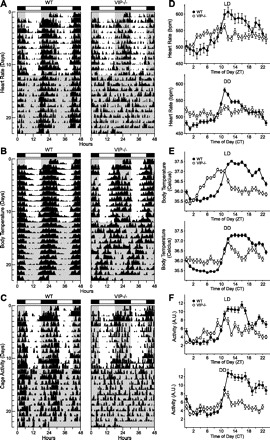Fig. 2.

Daily pattern of heart rate [HR; in beats/min (bpm)], body temperature, and cage activity [in arbitrary units (AU)] in WT and VIP-deficient mice. Double-plotted raster plots of HR (A), body temperature (B), and cage activity (C) from WT (left) and VIP-deficient mice (right) were created. Mice were trained in 12:12 light-dark (LD) conditions and then placed in constant darkness (DD). Shaded regions indicated when mice were in the dark. Each horizontal row represents a 24-h period that was plotted twice, and each day/row was plotted in succession. Ten days of HR, body temperature, and cage activity were averaged to produce group mean waveforms of HR (D), body temperature (E), and cage activity (F) for WT (n = 7) and VIP-deficient (n = 8) mice under LD (top) and DD (bottom) conditions. All of the WT mice showed strong diurnal and circadian rhythms of HR, body temperature, and cage activity (7 of 7 mice) under LD and DD conditions. VIP-deficient mice displayed dampened diurnal rhythms in HR (6 of 8 mice), body temperature (8 of 8 mice), and cage activity (7 of 8 mice) under LD conditions. Under DD conditions, VIP-deficient mice displayed a dampened circadian rhythm of body temperature (7 of 8 mice) and cage activity (2 of 8 mice). VIP-deficient mice did not display a circadian rhythm of HR under DD conditions (0 of 8 mice), as assessed by periodogram analysis.
